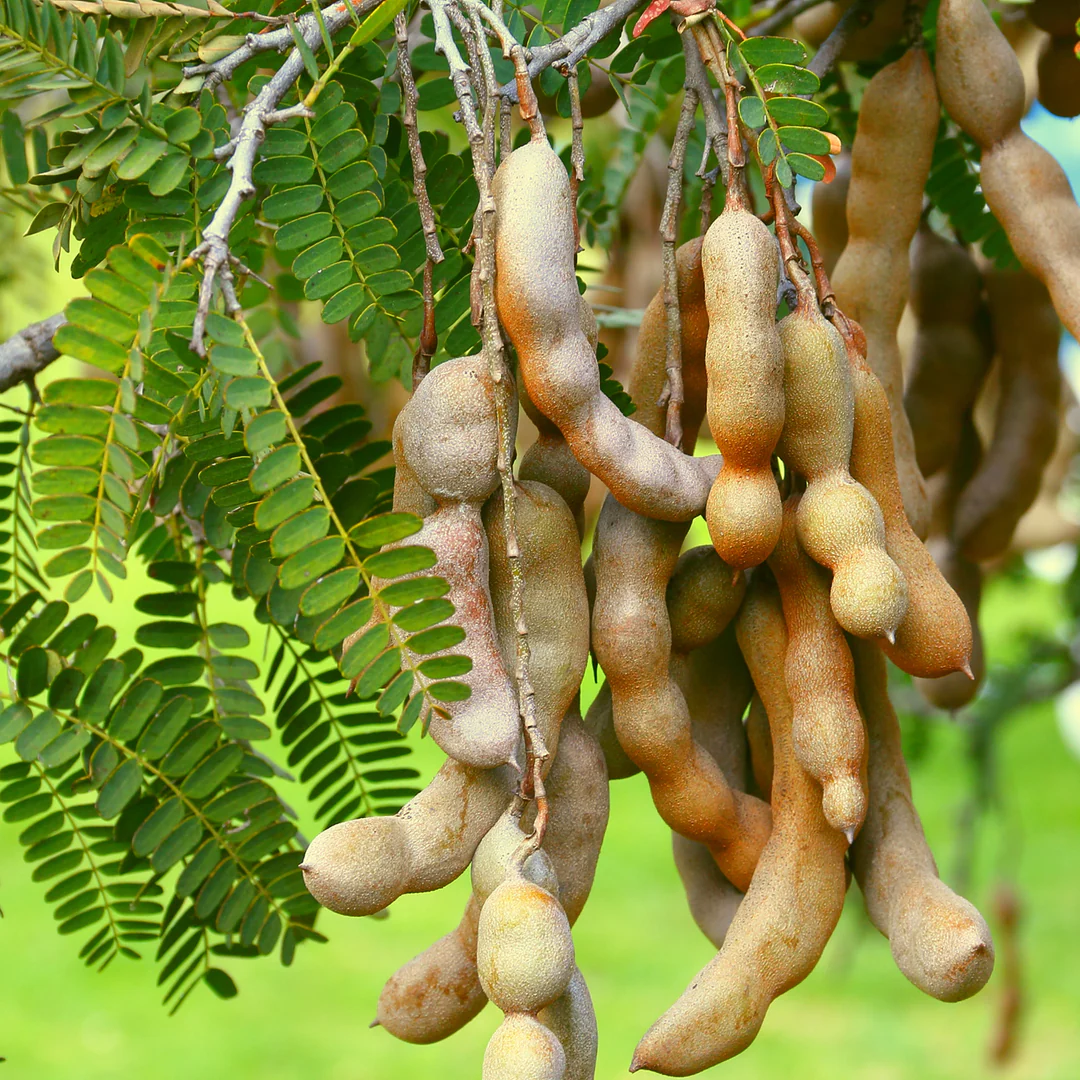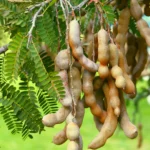Tamarind, scientifically known as Tamarindus indica, is a tropical tree known for its pod-like fruit that contains a tangy, sweet-sour pulp. The fruit is widely used in cooking, especially in South Asian, African, and Latin American cuisines, where it adds a distinctive flavor to a variety of dishes. Tamarind also has a long history of use in traditional medicine.
Botanical Information
- Scientific Name: Tamarindus indica
- Common Names: Tamarind, Indian Date
- Family: Fabaceae (Leguminosae)
Plant Characteristics
- Growth Habit: Tamarind is a large, evergreen tree that can grow up to 80 feet (24 meters) tall with a wide, spreading crown. It has a sturdy trunk and strong, drooping branches.
- Leaves: The leaves are pinnately compound, with 10-20 pairs of small, oblong leaflets that close at night. They are bright green and provide a dense canopy.
- Flowers: The tree produces small, yellow to pale pink flowers with red veins, arranged in clusters. The flowers are mildly fragrant and attract pollinators like bees.
- Fruit: The tamarind fruit is a brown, pod-like structure that is 4-8 inches (10-20 cm) long. The pod has a brittle outer shell and contains a sticky, brownish pulp surrounding several hard seeds. The pulp is tangy and sweet-sour, and it is the main edible part of the fruit.
Growing Conditions
- Climate: Tamarind thrives in tropical and subtropical climates and is best suited to USDA zones 10-12. It prefers hot, dry climates and is drought-tolerant once established. The tree can tolerate some frost but may suffer damage in extended cold periods.
- Sunlight: Requires full sun for optimal growth and fruit production, needing at least 6-8 hours of direct sunlight per day.
- Soil: Prefers deep, well-drained, sandy loam soils but can adapt to various soil types, including rocky and calcareous soils. It grows well in slightly acidic to neutral pH (6.0-7.5).
- Water: Requires moderate watering, especially during the establishment phase. Once mature, tamarind is drought-tolerant and can survive with minimal water.
Planting and Care
- Propagation: Tamarind is typically propagated from seeds, which should be soaked in water before planting to improve germination. It can also be propagated by cuttings, air layering, or grafting to produce true-to-type plants.
- Spacing: Space trees about 30-40 feet (9-12 meters) apart to allow for adequate air circulation and growth.
- Pruning: Minimal pruning is required, mainly to remove dead or diseased branches and to shape the tree. Pruning should be done carefully to avoid damaging the tree.
- Fertilization: Apply a balanced fertilizer or compost annually to support healthy growth and fruit production. Fertilize more frequently during the growing season.
Benefits and Uses
- Culinary Uses: Tamarind pulp is widely used in cooking, adding a tangy flavor to curries, sauces, chutneys, marinades, and beverages. It is a key ingredient in dishes such as pad Thai, Worcestershire sauce, and various Indian and African stews. The pulp is also used to make tamarind candy, jams, and drinks.
- Nutritional Value: Tamarind is rich in dietary fiber, vitamins (particularly vitamin C and B vitamins), and minerals like potassium, magnesium, and phosphorus. It is also a good source of antioxidants and provides a healthy energy boost.
- Medicinal Uses: Tamarind has been used in traditional medicine for its potential health benefits, including aiding digestion, treating fevers, and reducing inflammation. The fruit’s pulp is known for its laxative properties, while the seeds, leaves, and bark are used in various remedies for skin conditions, sore throats, and more.
- Other Uses: Tamarind wood is durable and used for making furniture, tools, and charcoal. The seeds are sometimes ground into flour or used in traditional cosmetics.
Cautions
- Pests and Diseases: Tamarind trees can be affected by pests such as scales, mealybugs, and fruit borers. They are also susceptible to fungal diseases like anthracnose and root rot. Regular monitoring and appropriate pest management practices can help maintain tree health.
- Harvesting: The fruit is harvested when the pods are fully mature and the pulp inside has dried to a sticky, paste-like consistency. Tamarind pods can be stored for several months in a cool, dry place.
Tamarind (Tamarindus indica) is a versatile and valuable tropical tree known for its distinctive tangy fruit and wide range of culinary and medicinal uses. Its adaptability to hot climates, coupled with its nutritional benefits and cultural significance, makes it a cherished tree in many parts of the world. With proper care and cultivation, tamarind can provide a bountiful harvest of this unique and flavorful fruit, enriching both kitchens and gardens alike.





















Reviews
There are no reviews yet.